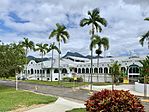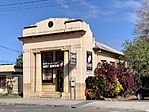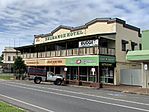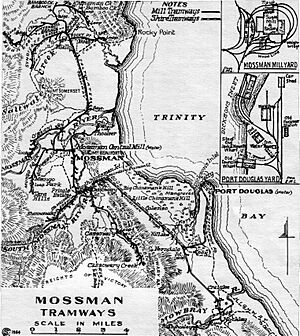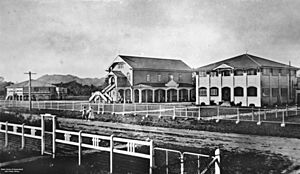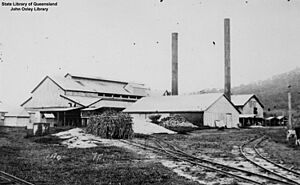Mossman, Queensland facts for kids
Quick facts for kids MossmanQueensland |
|||||||||||||||
|---|---|---|---|---|---|---|---|---|---|---|---|---|---|---|---|
|
From left to right;
Mossman District Hospital, Mossman Gorge National Bank of Australia, Exchange Hotel |
|||||||||||||||
| Population | 1,935 (2021 census) | ||||||||||||||
| • Density | 159.9/km2 (414/sq mi) | ||||||||||||||
| Postcode(s) | 4873 | ||||||||||||||
| Elevation | 12 m (39 ft) | ||||||||||||||
| Area | 12.1 km2 (4.7 sq mi) | ||||||||||||||
| Time zone | AEST (UTC+10:00) | ||||||||||||||
| Location |
|
||||||||||||||
| LGA(s) | Shire of Douglas | ||||||||||||||
| County | Solander | ||||||||||||||
| State electorate(s) | Cook | ||||||||||||||
| Federal Division(s) | Leichhardt | ||||||||||||||
|
|||||||||||||||
|
|||||||||||||||
Mossman is a small town in Queensland, Australia. It is located in the Shire of Douglas and is the main office for the local council. In 2021, about 1,935 people lived in Mossman.
Contents
Where is Mossman?
Mossman is in Far North Queensland, right on the Mossman River. It's about 75 kilometers (47 miles) north of the city of Cairns. The Mossman River flows through the area from west to east.
Just west of town is Mossman Gorge. This is a very popular spot inside Daintree National Park. It's also part of the amazing Wet Tropics of Queensland World Heritage area.
What Does Mossman Do?
Sugar cane farming is a big part of life and work in Mossman. The Mossman Central Mill is the only sugar mill in the area. It processes the sugar cane. After that, the sugar is sent to Cairns to be shipped around Australia and to other countries.
There's a special network of cane tramways in Mossman. These small railways help deliver the harvested sugar cane to the mill.
A Look Back at Mossman's History
Traditional Owners
The land around Mossman has a rich history. It is the traditional home of the Kuka-Dyangan people. The Kuku Yalanji language is also spoken in this area. It's an Aboriginal language of Far North Queensland.
How Mossman Got Its Name
The area was first called Mossman River. This name came from the Mossman River itself. Explorer George Elphinstone Dalrymple named the river in 1873. He named it after Hugh Mosman, who found gold in Charters Towers. For a short time, the town was also known as Hartsville. This was after an early settler named Daniel Hart. Later, the name changed to Mossman.
Early Days and Growth
The Mossman River Post Office opened in 1895. The Mossman Central Mill started crushing sugar cane on August 23, 1897. This mill was very important for the town's growth.
Mossman State School opened its doors on January 31, 1898. Later, in 1973, Mossman State High School opened for older students.
The town grew a lot because of the sugar mill. The district also had two special tramway systems. These small railways helped transport people, goods, and especially sugar cane. They were very important for the area before good roads were built.
Churches and Community
The first Catholic church in Mossman, St Augustine's, opened in 1906. In 1911, a strong cyclone hit Mossman. It caused a lot of damage, and the Catholic and Anglican churches were destroyed. A new St Augustine's Catholic Church opened in 1912.
In 1934, a new St Augustine's complex was built. It included a church, a school, and a convent. St Augustine's Catholic School started with 70 students. A new, modern St Augustine's church opened in 1977. The old church building became classrooms for the school.
World War II
During World War II, Mossman was affected by a Japanese air raid. On July 31, 1942, a single plane dropped a bomb. It landed near a house and caused an injury to a child.
Local Government Changes
Before 2008, Mossman was the main town for the Shire of Douglas. Then, it became part of the Cairns Region. But in 2014, the Shire of Douglas became its own local government area again.
Places to See
Mossman has several places that are listed for their special history. These include:
- Exchange Hotel
- St David's Anglican Church
- Mossman District Hospital
- Mossman Shire Hall and Douglas Shire Council Chambers
- National Bank of Australasia Building
Mossman Central Mill
The Mossman Central Mill Company Limited started in 1894. It was a co-operative, meaning local sugar cane farmers owned it together. The first sugar cane was crushed on August 23, 1897.
In 1906, the Mossman Mill became the first mill in Queensland to crush over 100,000 tonnes of cane in one season! For a long time, the sugar was sent by sea from Port Douglas. Later, it was taken by road to Cairns.
Mossman Mill was also a leader in technology. In 1971, it bought the first computer used for process control in the world's sugar industry. Sadly, the mill closed in 2024.
Schools in Mossman
Mossman has a few schools for young people:
- Mossman State School is a primary school for students from Prep to Year 6. It's located on Front Street. In 2017, it had 213 students.
- Mossman State High School is a secondary school for students from Year 7 to Year 12. It's also on Front Street. In 2017, it had 611 students and offers a special education program.
- St Augustine's School is a Catholic primary school for students from Prep to Year 6. It's on Grogan Street. In 2017, it had 217 students.
- The Tropical North Steiner School was approved to open in 2022. It will start with Prep to Year 3.
What's in Mossman?
Community Services
The Douglas Shire Council runs the Mossman Library at 14 Mill Street. The Mossman branch of the Queensland Country Women's Association (QCWA) also meets here.
Places of Worship
There are several churches in Mossman:
- St Augustine's Catholic Church
- St David's Anglican Church
- Mossman Uniting Church
- Mossman Seventh-Day Adventist Church
Health Services
Mossman Hospital is a public hospital at 9 Hospital Street. It has emergency services, clinics, and a pharmacy for patients.
Sports and Activities
Mossman has different sports clubs. One example is the Coral Coast Judo Club.


